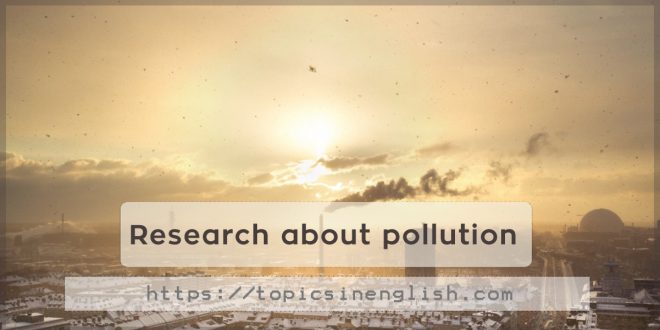Research about pollution, contains all the important and valuable information about pollution and all its types in detail.A ll that information you will find here in research about pollution.
Research about pollution
Pollution has become a growing phenomenon in this era and here we will provide you with a full research about pollution contains all the information on the causes and types of pollution .You will find all this information here in research about pollution.
Environmental Pollution;
The environment is all that surrounds human beings and non-living materials, and interrelationships between them; to ensure the continuity of life.
Based on the previous definition, the environment is all that God has created for us from trees, animals, seas, oceans, soil and others, with precision, mastery and balance.
It is the duty of all to preserve the environment and protect it from pollution, pollution occurs when pollutants enter the natural environment, disrupt their balance and negatively affect the life of living organisms.
These pollutants take many forms. They may be chemicals or natural energy, but are considered contaminated when they exceed natural levels.
Types of environmental pollution and its causes;
There are many types of environmental pollution, including : Air pollution, water, soil, noise, thermal. The following is a statement of each type, and its causes:
Air pollution;
Air pollution occurs when harmful gases, dust and smoke enter the atmosphere, causing physical, biological, or chemical changes in the air, affecting the lives of living organisms on Earth. The causes of air pollution include:
Combustion of fossil fuels: Sulfur dioxide from burning fossil fuels, such as oil and coal, is one of the main causes of air pollution.
Despite the importance of transportation from cars, planes and trains, but the excessive use of it pollutes air with carbon dioxide.
Carbon monoxide is the result of incomplete combustion of fuel, and natural and industrial processes produce nitrogen oxides that contribute to air pollution.
Agricultural activities: The excessive use of fertilizers, pesticides and insecticides in agricultural activities releases chemicals, such as ammonia, which pollutes both air and water.
Factory Smoke and Oil Refineries: These smoke releases carbon monoxide, hydrocarbons, organic compounds, and other harmful chemicals.
Mining operations: means the extraction of minerals from the ground, causing the release of dust and chemicals that pollute the air, and causes the problems of health for workers and residents of nearby areas.
Cleaning materials, wall coating materials: These materials cause air pollution due to chemicals emitted from them.
Water pollution;
Water pollution results from human activities that lead to the introduction of harmful substances into water bodies such as lakes, ponds, oceans, rivers, reservoirs, etc.
Water pollution can result from natural causes such as volcanoes, earthquakes, tsunamis. This type of pollution affects the lives of living organisms and plants that live in or near water, and drinking polluted water causes human diseases.
Some of the causes of water pollution are the following:
Dumping of industrial waste in water bodies: Industrial wastes contain chemicals such as lead, mercury, sulfur, asbestos, nitrates, and many other harmful substances that change the color of the water, increase the amount of minerals in it, and change its temperature, which poses a threat to the life of living organisms.
Wastewater: Wastewater discharges after treatment into the sea pollutes water with hazardous chemicals and bacteria that cause fatal diseases, such as malaria.
Mining operations: Minerals extracted from the ground and rocks contain metal waste and sulfide can increase the amount of toxic elements when mixed with water, which can lead to serious health problems.
Marine garbage: The accumulation of waste such as paper, aluminum, rubber, glass, plastic, and food in the sea pollutes sea water, and harms living organisms.
Occasional oil leakage: Oil leakage from marine carriers causes the introduction of toxic substances that do not dissolve in water and affect marine life and birds.
Burning fossil fuels: The burning of fossil fuels releases ash and particles containing chemicals mixed with rainwater and forming the so-called acid rain.
Agricultural activities: Fertilizers and pesticides used in agricultural activities contain chemicals mixed with rainwater, flowing into rivers, canals and causing serious damage to aquatic animals.
Landfills: When the rains fall, they mix with leaks from landfills and lead to groundwater contamination.
Animal waste: When the rains fall, they carry the waste of animals and transport them to the rivers, causing pollution. The contaminated river water causes many diseases such as dysentery, typhoid, cholera, diarrhea and jaundice.
Coal and oil leakage from transport pipes: These pipes are underground, and when oil leaks into the sea it does not dissolve in water, causing severe damage to marine organisms.
Soil pollution;
Land and soil pollution means the degradation or destruction of the earth’s surface and soil, directly or indirectly, as a result of human activities, limiting land productivity and quality as an ideal place for agriculture, forestry, construction.
Some of the causes of soil pollution are ;
Deforestation and soil erosion.
Agricultural activities, such as excessive use of fertilizers and pesticides.
Landfills, such as: the accumulation of waste such as aluminum, plastic, paper, cloth, wood, building materials, this reduces the beauty of cities, and pollutes land and soil.
Nuclear waste, such as burying nuclear waste and underground radioactive materials.
Wastewater, such as dumping of solid waste that remains after treatment of waste water in the landfill.
Noise Pollution;
Noise pollution means a lot of noise, or uncomfortable sounds that can temporarily disturb the natural balance, and causes hearing problems, sleep disorders.
The sources of noise pollution include:
plant machinery, such as: generators, compressors, mills, etc.
Social events, such as: weddings, meetings where the sounds of music rise.
Transportation, such as: aircraft, cars, trains, and others.
Equipment used to build bridges, dams, buildings, stations, roads, etc.
Household appliances such as vacuum cleaners, televisions, washing machines, and others.
Thermal pollution;
Thermal pollution occurs when a sudden rise in the temperature of bodies of water, which changes oxygen levels, causes damage to ecosystems.
The causes of thermal pollution include:
Water use to cool power plants and plant machines.
The high level of water bodies as a result of soil erosion, making it more susceptible to sunlight.
Cutting the trees that form a barrier prevent the direct sunlight from reaching the bodies of water.
High water temperature while running on hot paved surfaces, such as roads, parking lots.
Lightning, volcanoes,and warm lava that cause high temperature of water bodies.
Light pollution;
Light pollution results from the excessive use of artificial lights that alter the natural lighting of the environment, leading to disturbance of ecosystems, impact on human health and safety, wildlife, plant growth and increased energy consumption.
The causes of light pollution are:
Excessive use of decorative lights, street lighting, and incandescent signs at night.
Unauthorized use of lighting sources, such as leaving unused rooms lit.
Overcrowding in one area, leading to the presence of many light sources in a limited area.
Negative impacts of environmental pollution;
Environmental pollution causes many harmful effects, including:
The death of living organisms: Pollution in its multiple forms causes the death of large numbers of living organisms.
When air is polluted, enough light is not allowed to process photosynthesis.
The mixing of water with sulfur oxides, and nitrogen leads to the formation of acid rain, which kills many forms of life, and the pollution of the sea water with stains oil kills many living organisms living on the seas and oceans.
Health problems: Air pollution causes many diseases, including respiratory diseases such as asthma, sore throat, chest pain, lung cancer, and cardiovascular disease. Water pollution can cause skin irritation and rash, noise pollution causes stress, sleep disorders and hearing problems.
Global warming: The spread of cars and factories to release gases called greenhouse gases – such as carbon dioxide – which contributes to the heating of the atmosphere of the surface Earth, which is known as global warming, which leads to the melting of polar icebergs, and the rise of sea level, and this poses a threat to the lives of coastal populations.
Ozone depletion: Human activities produce many harmful chemicals, such as chlorofluorocarbons (CFCs) that cause corrosion of the ozone layer that protects the Earth from ultraviolet damage.
Lack of soil fertility: Soil is affected and less fertile because of the excessive use of fertilizers and pesticides, as well as chemicals leaking from industrial wastes. The lack of soil fertility damages plants and reduces their growth naturally.
We have provided you with a research about pollution ,and you can read more about pollution through the following short articles link:




